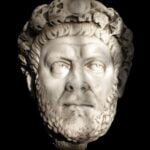Chapters
In the 3rd century CE, a new syncretic religion – Manichaeism – penetrated the areas of the Roman Empire from the Persian State. Its founder was the prophet Mani, and the doctrine itself combined elements of other religions: Gnosticism, Christianity, Mithraism, Zoroastrianism, Buddhism and Jainism.
However, the new religion met with a strong reaction from Roman state institutions: a number of legal documents were issued providing for penal sanctions for the followers of Manichaeism, first by emperors trying to restore the greatness of the Roman religion, and then by Christian emperors. Christians from the beginning considered Manichaeism to be heresy. In addition to the religious rivalry, there was a political aspect – the followers of the prophet Mani were considered agents of the Persian State, the traditionally great enemy of Rome.
The beginnings of a new religion in Persia
The founder of the new religion, Mani, was probably born in 215 or 216 CE. near Ctesiphon, his mother came from the Parthian royal Arsacid dynasty. He grew up in a family where the influences of Judaism and Christianity were strong, he knew the rules of the state religion of the Persian state – Zoroastrianism, he travelled to India – he met Buddhism. Mani combined certain elements of each religion, and created his own system of doctrines and a religious community. The new religion was universal and missionary in nature – its principles were not intended only for a small group of priests, thanks to which its group of followers was growing rapidly. Probably already around 240 CE. Mani sent missionaries to the borders of the Roman Empire. The prophet and his new religion gained the support of the eminent Persian king Shapur I. This king supported the spread of Manichaeism in Persia, probably seeing in the universality of religion the potential to gain wide public support for his rule. The number of followers of the new religion probably exceeded the followers of the existing state religion – Zoroastrianism. The two brothers of Shapur I became followers, but there is no evidence that the king himself converted to it. Mani held a high position during the victorious campaigns of the king of kings in the 50s of the 3rd century AD, which was a series of successes of Persian arms (battles of Edessa and Barbalissos, the capture of many cities in Syria) culminating in the capture of the emperor Valerian. Shapur I also supported the missionary activity of the new religion in the provinces of the Roman Empire. Since the Manichaean missionaries openly called for apostasy from traditional Roman religion, we may have one of the first-ever cases of the instrumental use of religion here. Did Shapur count on convincing a large part of the Roman East to the new religion, and thus internal weakness and a decrease in the population’s support for Roman power? The common religion of the inhabitants of the Roman provinces of Syria, Egypt, Asia Minor and the people of Persia could facilitate the incorporation of these areas into the borders of the Sassanid kingdom. If Shapur really thought so far, he should be included among the outstanding rulers of antiquity, not only because of his military successes. However, the priests of the state religion, Zoroastrianism, looked reluctantly at the development of the new religion. After the death of Shapur I, Mani also lost the support of the authorities, which, along with conflicts with representatives of the old religion, led to his being sentenced to death around 276 CE.
Missionary activity in the Roman Empire and the edict of Diocletian
Manichaean missionaries are known to have reached Egypt in 244 and 251 CE, and Rome before 280 CE. The new religion gained great popularity in the African provinces – not only in Egypt but throughout North Africa. The letters of Proconsul Julianus from 295-296 CE been preserved, which alerts the Roman central authorities about the high popularity of the Persian religion.
On March 31, 297 CE the emperor Diocletian issued an edict that hit the Manichaeans ruthlessly: the leaders were to be burned at the stake along with the writings. Ordinary believers had their property confiscated for the benefit of the state treasury, and in case of resistance, they were also condemned to death by beheading. The content of the edict is very critical of Manichaeism as a faith contrary to the principles of the Romans, accusing the followers of crimes, sowing unrest in cities and introducing foreign customs. In the edict of Diocletian, the origin of religion from Persia is repeatedly emphasized – a country hostile to the Roman Empire. However, the immediate successors of Diocletian did not continue such a hostile policy towards Manichaeism. Despite earlier persecution, the followers remained in the Roman Empire: the Christian writer Eusebius of Caesarea mentions that in 312 CE there were Manichaean communities in Rome. Another Christian writer, St. Hilary of Poitiers in Gaul (then Roman Pictavium) mentions a large share of the followers of the prophet Mani in the population of Gaul around 354 CE. Perhaps the Roman rulers no longer saw such a threat in the Manichaeans since this religion at the end of the 3rd century CE began to be persecuted also in Persia.
Further Anti-Manichaean legislation
The next ruler after Diocletian to issue a law attacking the Manicheans was Valentinian I. The Law C.Th. 16,5,3 issued by him in Trier on March 2, 372 CE, forbade gatherings, meetings, and attempts at conversion to Manichaeism. Contrary to the Diocletian edict of 297 CE, it did not explicitly condemn the principles of the religion of the prophet Mani. Emperor Valentinian was a tolerant and indifferent ruler to different religions, but paradoxically, it was this that contributed to the issuance of an anti-Manichaean legal act. The Manichaeans were accused of immoral behaviour and practising witchcraft and magic during assemblies. The emperor, feeling fear and suspicion of any esotericism, forbade gatherings where such practices were to take place.
The Act of Valentinian I postulated the separation of Mani’s followers from the rest of the community, but did not specify how it was to be done, presumably it was about banishing the followers from the cities.
A new persecution of the Manichaeans began after Emperor Theodosius I declared Christianity the dominant religion in the Roman Empire (Thessalonian edict of February 28, 380 CE, also signed by co-rulers: Gratian and Valentinian II).
Manichaeism was recognized as heresy, and certain dogmas were shared with Christianity: it was recognized that this religion, under the guise of similarities, distorts Christianity and leads its followers to false paths. The Thessalonian Edict established the so-called legal infamy of all heretics (and thus also Manicheans), i.e. deprivation of the right to act as witnesses, deprivation of the right to hold offices and perform public functions. In 381 CE the law of 372 CE was specified – the banishment of the followers of the Persian religion from the cities was ordered, and in 382 CE the death penalty for members of the Manichaean ascetic communities and financial penalties for ordinary believers were imposed. In 389 CE a law expelling the Manicheans from the city of Rome and its immediate vicinity was passed. In the early 5th century, during the reign of Honorius, previous legislation was confirmed and detailed provisions on legal infamy for followers of Manichaeism were added.
Confessing Manichaeism was a crime of lese-majesty, affecting the entire social sphere of Empire, which is why in the investigations against suspects, the testimonies of slaves and denunciations were accepted, and the guilty ones were denied a proper burial. You could also be found guilty posthumously. Special tribunals were sometimes established to conduct investigations, but for the most part, the burden of investigation rested with the officials of the Roman administration, who were fined for negligence.
As a result of the above regulations, Manichaeism in the west of the Empire probably disappeared in the 5th century CE. In the Eastern Roman Empire after 476 CE the anti-Manichaean laws were still detailed by Emperor Justinian, which led to the complete removal of the Persian religion from the areas of the former Roman Empire.







